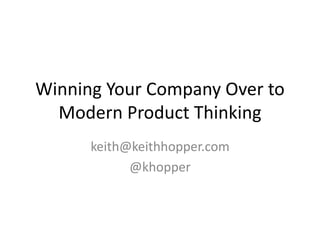
Modern Product Thinking: Win Teams Over With Small Goals
- 1. Winning Your Company Over to Modern Product Thinking keith@keithhopper.com @khopper
- 2. Keith Hopper coaches enterprise teams in how to rapidly bring the best new ideas to market and avoid costly missteps.
- 3. What is Modern Product Thinking? Modern Challenges • Lowered-barriers to entry • Rapidly evolving user needs • Need for being quick to market • Highly uncertain Modern Practices • Work in small, cross- functional teams • Plan and adjust iteratively • Fix time, vary scope • Put the user at the center • Identify and test hypotheses • Measure and learn
- 4. The Problem 1. The product market is increasingly competitive and dynamic 2. To respond, organizations need to change their approach to Product Management 3. It’s hard to bring change into an organization when you’re not in charge
- 5. • Disrupted by digital change • Seeing problems everywhere, internally and externally • Overwhelmed by directions they could go in; stuck • Had no clear answers The Christian Science Monitor is a 108 year old secular international news organization
- 6. How best to Help? • Small, x-functional team • Outside of normal business operations • One simple goal: “Demonstrate some type of new value to existing customers.” • Create a prototype and test it in a week
- 7. Design / Discovery Sprints AGILE (fixed-time iterations) LEAN (experimentation) DESIGN THINKING (user-centric)
- 8. Value: make a difference beyond reporting the news
- 9. Six-month Outcomes • Several testing iterations • Launched major new editorial initiative, digital property and campaign: csmonitor.com/redirect • Surpassed all existing internal metrics – Page engagement – Shares, Likes, Views – Sign-ups / conversions • Executive pronouncements embracing new product direction and methods • Org change creating PMs and cross-functional teams • Editorial and publishing on the same team
- 10. The Rider & the Elephant
- 11. Riders, Elephants & Paths
- 12. Elephants & Riders Have Issues • Riders get overwhelmed with options • Riders focus on problems, doubt • Riders get stuck in planning and analysis • Elephants do what is familiar, safe • Elephants don’t listen to reason for long • Elephants are motivated by fear
- 13. Direct the Rider • Focus on one, small behavior change • Create a single, achievable, near-term goal • Fight analysis by doing • Script the critical moves with specific and clear instructions on how to proceed • Help visualize a near-term destination
- 14. Motivate the Elephant • Address emotions, not logic – Social pressure, FOMO, pride, fear, safety, hope • Shrink the change, but make it meaningful • Create wins and immediate gratification • Expect and permit failure “en route” • Grow people: build reassurance and confidence
- 15. Shape the Path (Make the Journey Easier) • Avoid breaking existing habits • Build new habits • Give the team real skills and practice • Find the bright spots and highlight – behavior is contagious
- 16. How to Change Product Thinking • Focus on one small, near-term goal • Deploy a small team for a short timeframe • Deploy a proven, highly structured process • Avoid analysis paralysis through execution • Equip people with modern product skills • Create and celebrate small wins • Understand what’s working and highlight
Hinweis der Redaktion
- Gone are the days of big project plans w/ gant charts, and up-front requirements documentation, and stage-gate, linear development processes are increasingly becoming a thing of the past
- Instead of overhauling everything, or doing a complete industry analysis or putting a new leader in at the top, or creating some detailed innovation plan, I got them to agree to a teeny, tiny, little project.
- Sort of a best-of of modern product thinking
- Rider represents your logical, rational side. It analyzes, it creates plans, it sets direction The elephant is your motivation, your passion and your fears. It’s what moves you to do stuff. When the elephant and rider disagree on what to do, guess who wins? The elephant. It’s way bigger. You’ve all experienced this if you’ve ever hit the snooze bar, had the donut on the conference room table, skipped going to the gym, whatever.
- This should sound familiar. This is where The Monitor was at the beginning of our story.
- Influence emotions, not logic Introduce what others are doing (social pressure) Use a process that is proven to work (FOMO) Reflect on what has been accomplished (Pride) Deploy experts (Safety, Trust) Shrink the change, but make it meaningful Work in small, manageable tasks Create wins and immediate gratification Flush of victory gives elephants the strength to continue Create an environment where failure “en route” is expected and OK Grow people: build reassurance and confidence Achieve small goals Reflect and learn iteratively Motivated by social pressure – “look to the herd”. Wins = learning wins